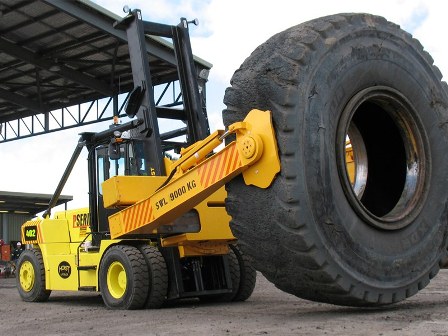Safe Forklift Operation according to OSHA
Powered Industrial Trucks (referred to as “forklifts” ) are used for material handling. These may include a fork, platform, and motorized hand trucks, as well as other specialized units powered by electric motors or internal combustion engines.
Forklift operators and employees working around these operations are at risk of hazards such as collisions, falls, tip-overs, and struck-by conditions.
Ways to prevent these hazards include:
- Forklift Operations
- • Always operate the vehicle according to the manufacturer’s instructions.
- • Always wear a seatbelt when the forklift has one.
- • Never exceed the rated load and ensure it is stable and balanced.
- • Do not raise or lower the load while traveling.
- • Keep a safe distance from platform and ramp edges.
- • Be aware of other vehicles in the work area.
- • Have clear visibility of the work area and ensure you have enough clearance when raising, loading, and operating a forklift.
- • Use proper footing and the handhold, if available, when entering the lift.
- • Use horns at cross aisles and obstructed areas.
- • Watch for pedestrians and observe the speed limit.
- • Do not give rides or use the forks to lift people.
- Safety Training
- • Only trained and certified workers may operate a forklift.
- • Ensure operators are trained on types of trucks in use.
- Forklift Maintenance
- • Remove from service any forklift found to be in unsafe operating condition.
- • Keep forklifts in clean condition; free of excess oil and grease.
- • Repair and maintain according to the manufacturer’s recommendations.
Forklift operations
Only trained, authorized persons are allowed to operate forklifts. Forklift operating guidelines include:
- No riders are allowed
- When left unattended, the forks shall be lowered, the power shall be shut off, and the parking brakes shall be engaged
- No driving in areas where potential flammable gases or vapors may be present unless the forklift is specially designed for that purpose
- While parked: do not block exits, accesses to stairways, eyewash stations, electrical panels, or fire equipment
- Operating at speeds that will permit a quick and safe stop
- Driving slowly while turning
- Maintaining a safe distance between the forklift and other moving objects
- Operating under control at all times
- Driving slowly and sounding the horn when passing through areas with an obstructed view
- Looking in the direction of travel
- Traversing ramps slowly and with caution
- Preventing stunt driving and horseplay as such behavior shall be subject to disciplinary action
- Avoiding objects in the roadway
- Ensuring provisions are made to assure no one will be passing directly under hoisted or suspended loads
Preparation for loading or unloading
Before forklifts enter the back of a truck or trailer to load or unload, the brakes shall be set and wheels chocked. If trailers are not attached to tractors, fixed jacks may be necessary to support the trailer and prevent it from upending.
Loading trucks
- Only loads within the rated capacity of the forklift may be handled safely. Loads shall be:
- Stable and safely arranged
- Kept as close as possible to the forklift with the forks tilted back slightly
- Monitored for safe clearance through aisles and doorways
- Kept safe by using dock boards (bridge plates) constructed with sufficient strength, when loading or unloading operations are taking place between vehicles and docks

Forklift Safety Procedures
Forklifts are extremely useful workplace vehicles, as long as they are used safely and appropriately by operators who are appropriately trained and competent to use them.
